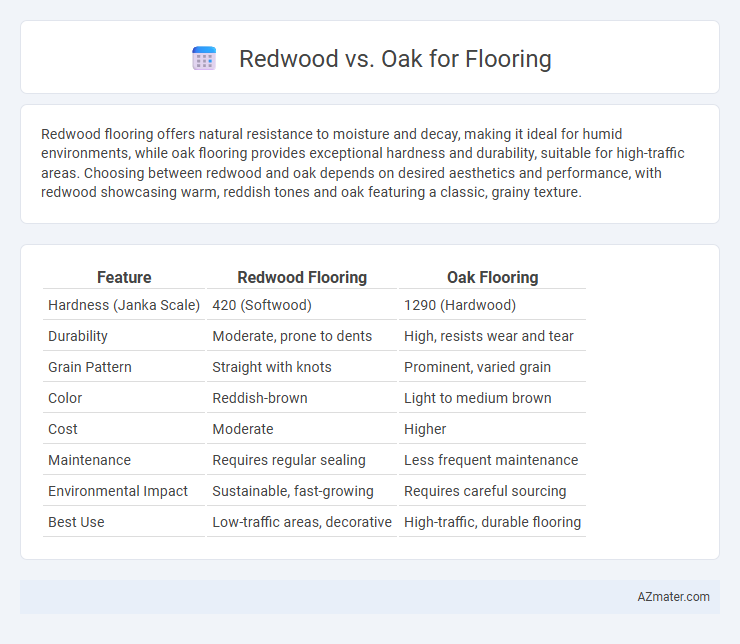Redwood flooring offers natural resistance to moisture and decay, making it ideal for humid environments, while oak flooring provides exceptional hardness and durability, suitable for high-traffic areas. Choosing between redwood and oak depends on desired aesthetics and performance, with redwood showcasing warm, reddish tones and oak featuring a classic, grainy texture.
Table of Comparison
| Feature | Redwood Flooring | Oak Flooring |
|---|---|---|
| Hardness (Janka Scale) | 420 (Softwood) | 1290 (Hardwood) |
| Durability | Moderate, prone to dents | High, resists wear and tear |
| Grain Pattern | Straight with knots | Prominent, varied grain |
| Color | Reddish-brown | Light to medium brown |
| Cost | Moderate | Higher |
| Maintenance | Requires regular sealing | Less frequent maintenance |
| Environmental Impact | Sustainable, fast-growing | Requires careful sourcing |
| Best Use | Low-traffic areas, decorative | High-traffic, durable flooring |
Introduction to Redwood and Oak Flooring
Redwood flooring offers exceptional durability and natural resistance to decay, making it ideal for high-traffic areas and outdoor use. Oak flooring, renowned for its strength and intricate grain patterns, provides a timeless aesthetic and excellent wear resistance suitable for both traditional and modern interiors. Both options boast unique color tones and hardness levels, affecting maintenance requirements and overall longevity in flooring applications.
Appearance and Grain Patterns
Redwood flooring features a rich, reddish-brown hue with straight, uniform grain patterns that create a warm, rustic appearance. Oak flooring offers a lighter color palette, ranging from pale tan to medium brown, with more pronounced and varied grain patterns, including swirls and knots that add character. The distinct grain intricacy of oak often provides a more textured visual appeal, while redwood's smoother, consistent grain lends a sleek, timeless elegance to interior spaces.
Durability and Hardness Comparison
Redwood flooring offers moderate durability with a Janka hardness rating around 450, making it softer and more prone to dents and scratches compared to oak. Oak, particularly red oak and white oak, boasts higher hardness ratings of 1290 and 1360 Janka respectively, delivering superior resistance to wear and impact for long-lasting flooring. The dense grain structure of oak provides enhanced durability, making it a preferred choice in high-traffic areas over the softer and more porous redwood.
Installation Process and Techniques
Redwood flooring offers easier installation due to its softer texture, which allows for effortless cutting and shaping, making it suitable for DIY projects. Oak flooring, known for its density and hardness, requires specialized tools and techniques such as precise nailing or stapling to ensure durability and stability during installation. Both woods need acclimation before installation to minimize expansion and contraction, but oak generally demands a more meticulous subfloor preparation for optimal results.
Maintenance and Care Requirements
Redwood flooring demands regular sealing and occasional sanding to maintain its natural oils and prevent moisture damage, making it moderately high in maintenance. Oak flooring is more durable and resistant to wear, requiring less frequent refinishing and simpler cleaning routines, which reduces long-term upkeep efforts. Both woods benefit from avoiding excessive moisture and using protective pads, but oak's harder grain structure offers better resilience against dents and scratches.
Environmental Impact and Sustainability
Redwood flooring offers a sustainable option due to its rapid growth rate and ability to be harvested from managed forests, reducing deforestation impact compared to oak. Oak flooring, while durable and long-lasting, typically comes from slower-growing hardwood forests, which can contribute to higher environmental strain if not sourced responsibly. Choosing FSC-certified wood, whether redwood or oak, ensures sustainable harvesting practices and supports forest conservation efforts.
Cost and Value Analysis
Redwood flooring generally costs between $7 to $10 per square foot, making it a mid-range option compared to oak, which ranges from $5 to $14 per square foot depending on species and finish. Oak offers superior hardness and durability, providing higher long-term value in high-traffic areas, while redwood's softer texture may require more maintenance but excels in aesthetic appeal and natural resistance to decay. Choosing between the two depends on balancing upfront cost against durability and maintenance, with oak often favored for longevity and redwood valued for unique style and moderate pricing.
Resistance to Moisture and Wear
Redwood flooring offers superior resistance to moisture due to its natural oils and porous structure, making it ideal for areas with higher humidity. Oak flooring, particularly white oak, provides exceptional wear resistance thanks to its dense grain and hardness rating of approximately 1,290 on the Janka scale. While oak is more durable under heavy foot traffic, redwood's moisture resistance makes it preferable in environments prone to dampness or occasional spills.
Popular Interior Design Applications
Redwood flooring offers a warm, reddish hue and natural resistance to decay, making it ideal for rustic and cabin-style interiors, while oak flooring provides exceptional durability and a classic, versatile grain suitable for both traditional and modern designs. Oak's availability in red and white varieties enhances its adaptability in high-traffic areas like living rooms and kitchens, where longevity and timeless appeal are crucial. Redwood's softness and distinctive knots add character to accent spaces such as bedrooms and cozy reading nooks, complementing natural or eclectic decor themes.
Choosing the Right Wood for Your Space
Redwood offers a warm, rich color and natural resistance to moisture and decay, making it ideal for humid environments or outdoor flooring. Oak is renowned for its durability, hardness, and classic grain patterns, providing a timeless, sturdy option perfect for high-traffic indoor spaces. Selecting between redwood and oak depends on your space's moisture conditions, traffic levels, and aesthetic preferences to ensure long-lasting beauty and performance.

Infographic: Redwood vs Oak for Flooring
 azmater.com
azmater.com